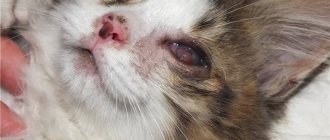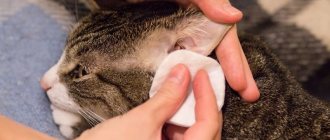Outside of illness, the cat scratches its ears when there is wax, shakes its head due to water getting in while bathing. If the itching is constant, and the animal scratches the skin until it bleeds, then the cause is often infection with ticks (otodectosis), fleas, inflammation of the skin (dermatitis due to allergies, infections). With a purulent process inside the ear (otitis), itching is accompanied by discharge with an unpleasant odor.
Skin irritation with the appearance of dandruff is explained by seborrhea, and swelling with a bluish color is due to shock and accumulation of blood (hematoma). When cats have ringworm, they scratch their ears and the hair on the affected area falls out. You can only try to rinse the ear canals with saline solution on your own to remove the wax plug.
In all other cases, they contact the veterinarian, he takes a scraping and sends the discharge for culture. Treatment includes drops with an antibacterial or antiparasitic effect (for example, Amitrazine), and the doctor also gives recommendations on nutrition and cleansing of the ears.
If a cat scratches its ears, is this always a sign of illness?
If a domestic cat scratches its ears, then outside of diseases it is usually associated with insufficient ear hygiene. Normally, cats independently cleanse the ear canal of wax and dirt during chewing. Some breeds (for example, Scottish Fold, Scottish Fold) have peculiarities in the structure of the ear; they need the owner’s help in cleansing the skin of wax.
If hygiene procedures are not carried out in time, a sulfur plug appears. It makes the cat feel uncomfortable, and he tries to get rid of the accumulation of earwax. However, it can be located deep and not visible upon examination. Because of this, the cat shakes his head, but the ears are clean on the outside.
With regular but aggressive cleaning of the ears and injury to the skin, wax begins to be produced in increased quantities, so all movements must be careful and not cause protest in the animal. If you are unable to cleanse yourself, you should seek help from a veterinarian.
Similar symptoms occur due to water getting into the ear canal when swimming. The cat begins to shake its head and rub its ears with its paws. Therefore, owners need to use a cap or ear plugs, and after the water procedure, carefully blot off excess water with cotton pads.
Erosion and ulcers of the ear in a cat
Erosion and ulcers in a cat’s ears are a manifestation of diseases of various etiologies. To diagnose and identify the causes of ulcers or erosion in the animal’s ears, it is necessary to conduct a comprehensive examination by a veterinarian. The doctor will conduct a cytological examination, hematological and biochemical tests.
Dermatitis
If the cause of erosive-ulcerative dermatitis in a cat is associated with malfunctions in the immune system, then at the initial stage the veterinarian will prescribe the use of mechanical means of protection to prevent self-injury. For example, an Elizabethan collar, overalls or anti-scratch boots.
For the treatment of immune diseases the following is used:
- corticosteroids;
- immunosuppressants.
Bacterial infections
Quite rarely, bacterial infections become the cause of ulcers and erosion in a cat’s ears. Treatment in this case consists of eliminating the cause and antimicrobial therapy. Effective methods of therapy can only be prescribed by a veterinarian after examination.
Neoplasms
It is extremely rare that papilloma, sarcoma or fibroma cause itching in a cat's ear. As these tumors grow, they lead to partial or complete hearing loss. To eliminate the tumor, the veterinarian performs surgery. In most cases, the prognosis is positive.
A cat scratches its ears: what to do to understand whether it’s time to see a doctor or not
If a cat scratches its ears constantly, then it is necessary to observe and conduct an external examination of the animal to identify the first signs of disease:
- the ears are hot, red or intensely pink;
- discharge of fluid or pus is visible inside the ear;
- there are scratches, scratch marks, bloody or yellow crusts on the surface;
- there was an unpleasant smell from the ears;
- instead of an even layer of hair near the auricle, bald spots appeared;
- the cat makes unnatural movements, as if trying to shake something out of its ear;
- the animal does not allow itself to be stroked on the head and the ear canal examined;
- the cat tries to scratch its ear on any objects;
- appetite has worsened;
- the cat sleeps or lies all the time, activity is lost.
Prevention measures
To prevent your pet from having ear problems, you need to properly care for the animal.
That means:
- Periodically inspect and clean sinks with a cotton swab.
- Control during bathing (you need to make sure that liquid does not get into the ear canal).
- Isolation of domestic animals from street animals.
- Ensuring proper nutrition for your pet. It should be balanced and varied. Vitamin supplements should be given periodically.
- Timely vaccination, deworming.
- Compliance with scheduled preventive examinations.
If a cat scratches its ears until it bleeds, shakes its head: the main reasons
If a cat scratches its ears until it bleeds and shakes its head, then the cause is:
- accumulation of blood due to injury - hematoma;
- inflammation of the outer, middle and inner ear - otitis media;
- infestation with fleas and ticks (otodecosis);
- allergic reaction to food, drugs, pollen;
- fungal infection (lichen);
- impaired sebum secretion - seborrhea;
- entry of a foreign body.
Hematoma (bruise)
When a head injury occurs, a fight with relatives, or compression of the ear, an accumulation of blood occurs - a hematoma. Its appearance is explained by slight injury to the delicate and thin skin of the ears, which have an active blood supply. Therefore, even a small impact is enough to damage blood vessels.
If the surface layer is not damaged, then the blood permeates the tissues, then the cat’s ear hurts and itches, and the damaged area swells and a bluish or purple color appears (bruise). The auricle changes shape, thickens, may sag or even be pressed against the head.
With a hematoma near the ear, the skin becomes hot, and a soft formation of varying sizes can be detected. The cat does not allow us to examine and palpate the ear because of the pain. A characteristic sign is tilting the head towards the affected area and general anxiety. Possible refusal of food and decreased physical activity.
Otitis of various etiologies
When a cat's ears are dirty and itchy, the cause is inflammation - otitis media. It occurs when infected with a bacterial, viral or fungal infection. Allergic and parasitic otitis media may also occur in cats. The provoking factor is hypothermia, water getting into the ear, weakening of the body due to concomitant illness, and fasting.
The development of the disease can be acute. Then the animal:
- local and general temperature increases;
- loss of appetite;
- any touch to the ears causes severe anxiety;
- there is brown or green discharge from the ear canal in the form of crumbs or a liquid, lumpy mass;
- redness of the ears occurs;
- activity is absent or reduced.
With otitis media, the cat meows and dodges stroking, and the itching is so unbearable that he scratches his ears until they bleed. Wounds can also fester, worsening the animal's condition.
If acute inflammation is not detected in time and the full course of treatment is not carried out, then otitis media becomes chronic. Periods of exacerbation alternate with subsiding of symptoms. Advanced disease leads to deafness, paralysis of the facial nerve, and infection in the brain. Extremely severe otitis media causes death.
According to the location of the lesion, otitis media can be external (inflammation of the external auditory canal, part of the auricle), middle (eardrum area) and internal (vestibular apparatus responsible for balance).
Flea infestation
If a cat twitches its ears and constantly scratches them with its paw, becomes restless and loses weight, then this may be due to flea infestation. These parasites can be found in both street and domestic animals. Infection occurs through contact with another cat, or the owner may bring fleas on shoes or clothes. Irritation of the skin of the ears and severe, continuous itching from parasite bites leads to inflammation - flea dermatitis.
This is especially difficult for young and elderly animals. If a kitten continuously scratches its ears and refuses to eat, then serious weakening of the body, weight loss, and anemia (anemia) are possible. Complications include allergic reactions, hair loss, suppuration of scratching wounds, and the addition of infectious diseases due to decreased immunity.
Allergic dermatitis internally
With allergic dermatitis, the cat's ears are red and itchy inside. The cause of allergy development is:
- genetic predisposition;
- incorrectly selected and low-quality food;
- individual intolerance to foods, cosmetics and hygiene products (shampoo, soap);
- contact with household chemicals, plants;
- medications;
- unfavorable environmental conditions;
- chronic bronchial diseases, asthma;
- intestinal dysbiosis;
- worms, fleas, ticks;
- skin diseases.
With allergies, the cat most often scratches its eyes and ears, there is redness of the eyelids and watery eyes, difficulty breathing, sneezing, and coughing. Animals develop rashes, swelling of paws, hair loss, vomiting and diarrhea.
Ringworm (fungal infection of the skin of the ear)
With lichen, the cat scratches its ears until there are “sores” (wounds). It most often develops during infection caused by trichophytosis and microsporia fungi. Risk factors:
- walking outside;
- malnutrition;
- infection with worms;
- drop in immune defense when using potent drugs;
- tumor process
Ringworm near the ear causes:
- severe itching;
- hair loss;
- the appearance of round or oval spots with a clear rim, peeling, vesicles or pustular elements are noticeable in their center;
- inflammatory reaction with redness of the skin;
- the skin of the affected areas becomes discolored.
Similar symptoms are possible with allergic diseases and viral infections, so an accurate diagnosis can only be made after an examination.
Otodectosis is the most common cause of severe itching
Severe itching very often occurs in cats with otodectosis. This disease is also called ear scabies, which is caused by the otodectosis mite. It is not visible when examining the ear because it is extremely small.
Crusts on the ears become a sign of infection; they appear due to an inflammatory reaction to the waste products of the parasite. A tick can get to a cat through direct contact with another infected animal or through the use of a shared object (for example, a bed). There is a risk of getting a parasitic infection when bitten by a flea that carries a tick from a sick cat.
The first sign of the disease is persistent itching of the ears, the cat presses its ears and shakes or shakes its head. The animal constantly scratches the skin inside the ear, which leads to its damage and infection. When examining the ear, you can notice dark brown crusts in the depths of the ear canal. They form at the stage when the tick has already penetrated into distant areas. Discharge from the ear takes on an unpleasant odor.
Advanced forms of otodectosis are accompanied by complications:
- inflammation of the eardrum;
- hearing loss;
- spread of mites into the brain with the development of encephalitis.
If the disease is not treated, there is a risk of death.
Seborrhea, a sign - the cat scratched behind the ear
If a cat scratches behind the ear and there are pieces of skin (dandruff) on the fur, then this is considered a sign of seborrhea. It develops when the function of the sebaceous glands is impaired. Their increased activity is a congenital feature or occurs against the background of:
- otodectosis,
- allergic dermatitis,
- flea infestation,
- pustular infection,
- thyroid diseases,
- hormonal imbalances,
- scabies,
- malnutrition.
In the dry form of seborrhea, the cat is mainly bothered by itching, but in the wet form, the hair falls out and inflammation occurs in the form of red spots. When scratching the skin, secondary bacterial infection, suppuration, and an unpleasant odor are possible.
Foreign body
The cat scratches and shakes its head when foreign objects enter the ear canal. It cannot always be seen without special equipment (otoscope) and you should not try to pull it out without a doctor. If the attempt is unsuccessful, the object may be pushed into deeper parts.
Treatment of ear diseases
To make a diagnosis, it is necessary not only to see the picture of the patient’s clinic, but also to take into account various tissue tests.
The doctor will prescribe treatment depending on the sum of all indicators.
- These can be antimicrobial, antiviral, antiallergic drugs, antibiotics and homeopathic remedies.
- The treatment process can be adjusted, especially with regard to fungal infections and mites.
- For hematomas and neoplasms, the help of a surgeon will be required.
Self-medication can only complicate the process. It is necessary to remember not only about the complications, but also about the harm that can be caused to your little friend when using inappropriate medications.
The cat's ears itch inside: what to do at home
If your cat's ears itch, but there are no signs of inflammation (redness, irritation) or scratching, then you can clean the earwax from the ears at home. To do this, use a sterile saline solution (0.9% sodium chloride), a pipette and cotton swabs with special limiters.
Every day for 7 days in a row, 2 drops of saline solution are dripped into each ear 3 times a day. It should have a temperature of 38 degrees; to warm it up, the pipette is lowered into warm water. Within a week, the plug usually softens, falls out and comes out. You can remove the remaining earwax with cotton swabs.
You should not wash your cat's ears with hydrogen peroxide, soap or alcohol solution. It is forbidden to use thermal procedures, since in the presence of a purulent infection this will lead to its spread to the membranes of the brain.
How to help your pet
An attentive owner will always notice in time any unwanted changes in the appearance of his pet. A responsible owner should definitely consult a veterinary dermatologist. It must be remembered that only with an accurate diagnosis can adequate treatment be carried out.
Modern veterinary clinics have all the conditions and equipment to carry out diagnostic procedures and issue an error-free medical opinion. The sick cat will be thoroughly examined and the necessary tests will be carried out:
- blood test: general, biochemical;
- a blood test for the presence of immunoglobulins to determine the likelihood of an allergy;
- scraping from the affected area of the skin.
This way, the veterinarian will get a complete picture of your health status and the causes of baldness and prescribe the appropriate treatment.
What you should absolutely not do: if your cat has a bald spot, and the skin in this area is red and inflamed, you should not self-medicate and use various ointments without the recommendation of a veterinarian. You should take the animal to the clinic as soon as possible.
How to treat a cat scratching its ears
If a cat scratches its ears due to otodectosis, then first it is necessary to remove traces of the tick's vital activity with lotions Fitolar, Rosinka, Opti Free, Otoklin. Then drops are prescribed:
- Frontline Spot - 0.5 ml is dripped into the ear and gently rubbed into the skin, the drug also helps to destroy lice and fleas;
- Amitrazine - instill 0.5 ml in small animals and kittens, 1 ml in large and adult cats for 7 days, the drops destroy larvae and mites, relieve inflammation and help healing;
- Stronghold - dripped onto the withers, spreading the fur, once at 6 mg/kg of weight.
Small hematomas resolve on their own, and to prevent infection, antibiotic drops or Furacilin solution are prescribed. If there is a large accumulation of blood, it is removed, the cavity is surgically treated and a bandage is applied.
To treat otitis, antibacterial, antiviral, antifungal agents are used (Otibiovin, Mastiet, Otonazole), but after identifying the causative agent of the infection. If the cause is an allergy, then drops with hormones may be prescribed. For dry seborrhea, moisturizers are used in the form of additives for the water in which the cat is bathed (lactic acid, sodium lactate). For wet seborrhea, use “Doctor” or “Tea Tree” shampoo.
In case of food allergies, cats are prescribed special food, and in case of contact allergies, it is important to eliminate the animal’s presence near the allergen. Hormonal and antihistamine medications are used to relieve symptoms. For lichen, they are treated with the antifungal agent Biopirox.
Watch the video on how to clean a cat's ears:
Diagnostics
The appearance of persistent itching in the ear area of a cat requires examination by a veterinarian. The doctor conducts an external examination of the auricle and examines the internal parts of the ear canal with an otoscope. This makes it possible to determine the presence of damage to the eardrum, the degree and extent of the inflammatory process, and discharge.
To determine the causative agent of the infection, a scraping is taken from the ear canal and a culture is performed to determine the bacteria and their sensitivity to antibiotics. It is often necessary to take a blood test to assess your immune system.
Surgical solution to the problem
Surgical treatment is prescribed in the presence of a large hematoma that cannot resolve on its own, or in the presence of an abscess near the ear canal. They are opened, washed with antiseptic solutions and a bandage is applied. In the postoperative period, antibiotics are prescribed in drops, ointments, and injections.
Surgery is also necessary if a foreign body penetrates deep into the ear. It is recommended when it is impossible to remove the object in the usual way. Surgery is performed only under X-ray control.
Diagnosis of the condition
An unpleasant sensation that causes a strong desire to scratch is itching. This condition in an animal is an obvious sign of skin damage. In veterinary medicine, there are 2 types of disorders:
- Localized type, when one or several places on the pet’s body begin to itch. Sometimes scratches appear only on the face, as well as on the neck and cheeks.
- Generalized type, which involves the appearance of sores on the entire body of the animal.
If you notice that your cat is itching a lot and drops of blood appear in the scratching areas, you need to contact a specialist at a veterinary clinic. To begin with, the pet is examined for the presence of blood-sucking parasites, which can cause severe stress in both couch potatoes and walking individuals. Scratch marks from bites are most often found on the chin, cheeks, neck, and tail. If fleas or ticks are not detected, then we are talking about other, more serious reasons.
After questioning the owner, the doctor will scrape the damaged area on the pet’s skin. Examination of the sample in the laboratory helps to identify the causative agent of the disease. Additional tests may also be ordered.
Once the exact disease is determined, the veterinarian prescribes treatment and gives additional recommendations on nutrition and care for the recovering patient.
Unfortunately, owners go to the veterinary clinic too late: when they discover severe wounds, bleeding scratches or bald patches on the pet’s body. This is the next stage of the pathology, which causes severe discomfort and can lead to severe infection. The duty of a good owner is to notice and respond to the problem in a timely manner.
How to treat if a cat scratches his ear until it bleeds
If the cat scratches the ear until it bleeds, then the wound is treated with hydrogen peroxide and sprinkled with crushed Streptocide tablets or lubricated with Panthenol, Trauma-gel or Ranosan ointment. It is not recommended to use iodine, brilliant green and Vishnevsky liniment on the auricle. These products have a strong cauterizing effect and can cause burns.
Diagnostic methods
When making a diagnosis, the veterinarian examines the animal's ears using an otoscope. If a tick infestation is suspected, a scraping of dark plaque is taken and examined under a microscope. Other diagnostic methods are also used:
- collection of secretions for bacteriological analysis;
- testing for allergic reactions;
- blood test to determine the general condition of the cat’s body;
- cytological examination of the contents of the auricle.
If, after testing, it is not possible to determine the exact cause of the abnormalities, the veterinarian will order an x-ray to rule out the formation of a tumor. In difficult cases, CT and MRI are performed, which can reveal the spread of inflammation to neighboring organs.
Is it possible to prevent itching in an animal?
Preventive measures to reduce the risk of itchy ears in cats include:
- regular examination of the ears;
- purification from sulfur;
- treatment against parasites (domestic cats also need it);
- vaccinations on schedule;
- preventing water from getting into the ears when swimming, drying with cotton pads in case of numbness;
- avoiding hypothermia;
- strengthening the immune system with vitamins and nutritious food;
- Contact your veterinarian early if unusual symptoms appear.
To prevent diseases, you should not use antibacterial drugs or start treatment with them without examination. This leads to allergic reactions, development of drug resistance and the development of fungal skin diseases.
Itching of a cat's ears can be associated with wax plugs or water ingress, but if it is severe and prolonged with scratching of the skin, it is necessary to exclude infection, allergies, trauma, or foreign body ingress. Treatment is most often medicinal - ear drops, ointments. For prevention, you need to inspect and clean the ear canal.
Preventive measures
As a preventive measure, you need to regularly clean your animal’s ears. To do this, you must use products prescribed by your veterinarian. Cleaning should not injure the hearing organs; it must be done very carefully.
It is necessary to periodically check and examine your tailed friend, and consult a clinic when the first signs of various ailments appear.











